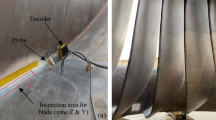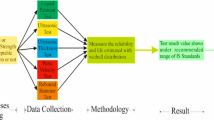Abstract
Due to the importance of energy production, it is critical to reduce unnecessary or unpredicted power generation equipment outages. As a major power generation company, Hydro-Québec uses models to estimate the service life of turbine runners in order to avoid such outages. The influential inputs for these models include the characteristics of flaws present in the runners. Since Non-destructive testing (NDT) methods are used to detect and characterize these flaws, this study aims to evaluate the reliability of NDT methods for inspection of weld joints in hydraulic turbine runners. Conventional ultrasonic testing (UT), radiography testing (RT), phased array ultrasonic testing (PAUT), and PAUT using total focusing method (TFM) were compared. The NDT tests were conducted on a T-joint specimen manufactured with embedded flaws. This specimen was used to determine the probability of detection (POD) curves for volumetric flaw sizes. The results showed that array technology, PAUT or TFM, has demonstrated a detection capability (a90) around 2.5 mm, which is similar to the commonly used equivalent critical flaw size for such structure.










Similar content being viewed by others
Data availability
All the data sets on which the conclusions of the paper rely are presented here. Upon request, all relevant raw data will be freely available to any researcher wishing to use them for non-commercial purposes.
References
Paoliello FA (2005) Guidelines for integrity evaluation and remaining life assessment of recovery boilers. Tappi J 88(2):17–22
Boukani Habibzadeh H (2018) Evaluation of the reliability of nondestructive ultrasonic inspection methods for the detection and the characterization of defects in hydroelectric turbine welded joints (Doctoral dissertation, École de technologies supérieure, Montreal Quebec, Canada). https://espace.etsmtl.ca/id/eprint/2042/1/HABIBZADEH_BOUKANI_Hamid.pdf
Thibault D, Gagnon M, Godin S (2015) The effect of materials properties on the reliability of hydraulic turbine runners. Int J Fluid Machin Syst 8(4):254–263. https://doi.org/10.5293/IJFMS.2015.8.4.254
Bajgholi ME, Rousseau G, Viens M, Thibault D (2021) Capability of advanced ultrasonic inspection technologies for hydraulic turbine runners. Appl Sci 11(10):4681. https://doi.org/10.3390/app11104681
Gagnon M, Tahan A, Bocher P, Thibault DA (2013) Probabilistic model for the onset of high cycle fatigue (HCF) crack propagation: application to hydroelectric turbine runner. Int J Fatigue 47:300–330. https://doi.org/10.1016/j.ijfatigue.2012.09.011
Boukani HH, Viens M, Tahan SA, Gagnon M (2018) Case study on the integrity and nondestructive inspection of flux-cored arc welded joints of Francis turbine runners. Int J Adv Manuf Technol 98:2201–2211. https://doi.org/10.1007/s00170-018-2139-y
Morin O, Thibault D, Gagnon M (2021) On the Comparison of Hydroelectric RunnerFatigue Failure Risk Based on Site Measurements. IOP Conference Series: Earth and Environmental Science 774(1):012126. https://iopscience.iop.org/article/10.1088/1755-1315/774/1/012126/pdf
Boukani HH, Viens M, Tahan SA, Gagnon M (2014) On the performance ofnondestructive testing methods in the hydroelectric turbine industry. IOP ConferenceSeries: Earth and Environmental Science 22(1):012018. https://doi.org/10.1088/1755-1315/22/1/012018
Zhang J, Li XH, Shi YK, Liang LS (2014) Phased array ultrasonic inspection of embedded defects in hydropower turbine runner welds. Insight: Non-Destructive Testing Condition Monit 56:390–394
Zhang Y, Li X, Zhang J, Ding H (2011) Model-based reliability analysis of PA ultrasonic testing for weld of hydro turbine runner. In Proc Procedia Eng 16:832–839. https://doi.org/10.1016/j.proeng.2011.08.1162
Bajgholi ME, Viens M, Rousseau G, Habibzadeh H (2019) Evaluation of the dead zones in the welded joints of hydraulic turbine runners. NDT Conference in Canada, Edmonton, AB, Canada. https://www.ndt.net/search/docs.php3?id=24715
Canadian Standards Association (CSA) (2013) CSA W59–13 Welded Steel Construction (Metal Arc Welding). Mississauga, ON, Canada
Bajgholi ME, Rousseau G, Viens M, Thibault D (2020) Performance of Ultrasonic Inspection on hydroelectric turbine runner. 3rd International Symposium on Structural Health Monitoring and Nondestructive Testing (Quebec City, QC, Canada, Nov. 25-26, 2020). https://www.ndt.net/search/docs.php3?id=25561
ISO 19675 Non-Destructive Testing—Ultrasonic Testing—Specification for a Calibration Block for Phased Array Testing (PAUT). International Organization for Standardization: Geneva, Switzerland, 2017
Holmes C, Drinkwater BW, Wilcox PD (2008) Advanced post-processing for scanned ultrasonic arrays: application to defect detection and classification in non-destructive evaluation. Ultrasonics 48:636–642. https://doi.org/10.1016/j.ultras.2008.07.019
ASME Boiler and Pressure Vessel Code, Section V Art. 4 (2021) Mandatory Appendix XI full matrix capture (FMC) and nonmandatory Appendix F examination of welds using full matrix capture (FMC). The American Society of Mechanical Engineers, New York, USA
BS ISO 23864: 2021 BSI standards publication non-destructive testing, ultrasonic testing, use of automated total focusing technique (TFM) and related technologies. 2021
BS ISO 23865: 2021 BSI standards publication non-destructive testing, ultrasonic testing, General use of full matrix capture/total focusing technique (FMC/TFM) and related technologies. 2021
Ginzel E (2013) Phased Array Ultrasonic Technology. Eclipse Scientific Products Incorporated, Waterloo, ON, Canada
Zetec (2016) Probes & Wedges for Ultrasonic testing, (REV 12-01-2016). https://www.zetec.com/wp-content/uploads/2016/11/2016-UT-Probe-Catalog-Content_R20161125.pdf
ISO. (2012). ISO 9712: 2012 Non‐Destructive Testing—Qualification and Certification of NDT Personnel
Industrial Radiography Image forming techniques GE Inspection Technologies (2006). www.geinspectiontechnologies.com/en
Zolfaghari A, Kolahan F (2017) Reliability and sensitivity of visible liquid penetrant NDT for inspection of welded components. Mater Test 59:290–294. https://doi.org/10.3139/120.111000
Georgiou GA (2007) POD curves, their derivation, applications, and limitations. Insight-Non-Destr Test Cond Monit 49(7):409–414. https://doi.org/10.1784/insi.2007.49.7.409
Annis C (2009) Nondestructive evaluation system reliabilityassessment, MIL-HDBK-1823A. U.S. Department of Defense, Philadelphia
Foucher F, Fernandez R, Leberre S, Calmon P (2018, June) New tools in CIVA for Model Assisted Probability of Detection (MAPOD) to support NDE reliability studies. In NDE of Aerospace Materials & Structures 2018 (pp. 32–43). http://www.extende.com/files/extende/publications/2018_ASNT-Aerospace_Foucher_ToolsinCIVAforReliabilityStudies_EN.pdf
ASTM E2862, 18 (2018) Standard practice for the probability of detection analysis for hit/miss data. West Conshohocken, Pennsylvania
ASTM E3023, 15 (2015) Standard Practice for Probability of Detection Analysis for â Versus a Data. ASTM International, West Conshohocken, Pennsylvania
Malik MS (2016) Model assisted POD of laser-ultrasonics NDT for train axles: a review on International Conference on Electrical, Electronics, and Optimization Techniques, ICEEOT 4645–48. https://doi.org/10.1109/ICEEOT.2016.7755600
Chapuis B, Calmon P, Jenson F (2017) Best practices for the use of simulation in POD curves estimation: application to UT weld inspection; ISBN 9783319626598
Annis C (2022) Statistical best-practices for building probability of detection (POD) models. R package mh1823, version 5.4.5. https://statistical-engineering.com/mh1823-history/
CIVA computer simulation package, POD Model (2020) https://www.extende.com/
Harding CA, Hugo GR (2011) Guidelines for interpretation of published data on probability of detection for nondestructive testing; Maritime Platforms Division DSTO Defence Science and Technology Organisation 506 Lorimer St Fishermans Bend, Victoria 3207 Australia
Kurz JH, Jüngert A, Dugan S, Dobmann G, Boller C (2013) Reliability considerations of NDT by probability of detection (POD) determination using ultrasound phased array. Eng Fail Anal 35:6090–6617. https://doi.org/10.1016/j.engfailanal.2013.06.008
Safizadeh MS, Forsyth DS, Fahr A (2004) The effect of flaw size distribution on the estimation of POD insight non-destructive test. Cond Monit 46:355–359. https://doi.org/10.1784/insi.46.6.355.56380
Ermolov IN (1972) The reflection of ultrasonic waves from targets of simple geometry. Nondestructive Testing Journal 5(2):87–91
GINZEL ED (2011) Fun with Civa, NDT.net Journal. https://www.ndt.net/article/ndtnet/2011/23_Ginzel.pdf
Annis C, Gandossi L, Martin O (2013) Optimal sample size for probability of detection curves. Nucl Eng Des 262:98–105. https://doi.org/10.1016/j.nucengdes.2013.03.059
ASME Boiler and Pressure Vessel Code, Section V Art. 4 (2021) Ultrasonic examination methods for welds. The American Society of Mechanical Engineers, New York, USA
Bajgholi ME, Rousseau G, Ginzel E, Thibault D, Viens M (2023) Total focusing method applied to probability of detection. Int J Adv Manuf Technol 126(7–8):3637–3647
Ginzel E, Bajgholi M, Guimarães MBM, Foucher F, Rousseau G, Viens M (2022) Total focusing method used for flaw sizing in probability of detection determination
Carignan J, Despaux M-P, Lachance F, Rioux P (2019) Sensitivity response of total focusing method (TFM) for weld inspection versus other techniques,https://www.ndt.net/article/ndtcanada2019/papers/Despaux_2019136SONATEST_Paper_Sensitivity_Response_of_TFM_for_Weld_Inspection_vs_Other_Techniques(Marie-Pierre_DESPAUX).pdf
Rachev RK, Wilcox PD, Velichko A, McAughey K (2018) Ultrasonic immersion testing for crack detection and depth sizing in large diameter pipes. https://www.ndt.net/article/ecndt2018/papers/ecndt-0084-2018.pdf
Peng C, Baib L, Zhang J, Drinkwater B (2018) The sizing of small surface-breaking fatigue cracks using ultrasonic arrays. https://www.ndt.net/article/ndt-review/papers/1-s2.0S0963869518301567-main.pdf
Volf O (2020) Crack growth monitoring with phased-array total focusing method (TFM), https://www.ndt.net/article/ndtnet/papers/Crack_Growth_Monitoring_with_Phasedarray_Total_Focusing_Method_TFM.pdf
Holloway P, Ginzel E (2021) TFMiTM part 2: improved imaging with 3D rendering. https://www.ndt.net/article/UTonline2021/Paper/14_Holloway.pdf
Holloway P, Ginzel E (2021) TFMiTM: using intermodal analysis to improve TFM imaging, https://www.ndt.net/article/ndtnet/papers/TFMi__Using_Intermodal_Analysis_to_Improve_TFM_Imaging.pdf
Bajgholi M (2023) Advanced ultrasonic inspection technologies applied to the welded joints of hydraulic turbine runners (Doctoral dissertation, École de technologie supérieure), Montreal, QC, Canada. https://espace.etsmtl.ca/id/eprint/3196/1/BAJGHOLI_Mohammadebrahim.pdf
Ishii J, Hiramatsu Y, Funato K (2007) Novel repair technique for life-extension of hydraulic turbine components in hydroelectric power stations Intl. Conf. on Power Engineering (Hangzhou, China)
Acknowledgements
The authors would like to gratefully thank the Institute de Recherche d’Hydro-Québec (IREQ), Quebec Metallurgy Center (CMQ), Mitacs Acceleration Program, oN DuTy! Program, and the École de Technologie Supérieure (ÉTS) for their support and financial contribution. Additionally, the authors would like to extend their gratitude to Edward Ginzel, Jeremy Carignan, Mariana Burrowes, and Fabrice Foucher for their valuable technical discussions.
Funding
This study is financially supported under the MITACS Accelerate program in collaboration with the Institute de Recherche d’Hydro-Quebec (IREQ). The corresponding author is also financially supported by the “oN DuTy!” program. oN DuTy! is an initiative developed under the Collaborative Research and Training Experience (CREATE) of the National Sciences and Engineering Research Council of Canada (NSERC) (http://www.ondutycanada.ca/ (accessed on 13 September 2022)).
Author information
Authors and Affiliations
Contributions
Conceptualization: M.E.B. Formal analysis: M.E.B. Funding acquisition: D.T. Investigation: G.R. and M.G. Methodology: M.E.B. and G.R. Software: M.E.B. Supervision: M.V. Validation: G.R. Writing—original draft: M.E.B. Writing—review and editing: G.R., M.G., D.T., and M.V. All authors have read and agreed to the published version of the manuscript.
Corresponding author
Ethics declarations
Ethics approval and consent to participate
The authors have made the necessary efforts to respect ethical guidelines and follow the rules of good scientific practice.
Consent for publication
All authors agreed with the content of this paper and gave their explicit consent to submit it.
Competing interests
The authors declare no competing interests.
Additional information
Publisher's note
Springer Nature remains neutral with regard to jurisdictional claims in published maps and institutional affiliations.
Rights and permissions
Springer Nature or its licensor (e.g. a society or other partner) holds exclusive rights to this article under a publishing agreement with the author(s) or other rightsholder(s); author self-archiving of the accepted manuscript version of this article is solely governed by the terms of such publishing agreement and applicable law.
About this article
Cite this article
Bajgholi, M.E., Rousseau, G., Viens, M. et al. Reliability assessment of non-destructive testing (NDT) for the inspection of weld joints in the hydroelectric turbine industry. Int J Adv Manuf Technol 128, 4223–4233 (2023). https://doi.org/10.1007/s00170-023-12176-5
Received:
Accepted:
Published:
Issue Date:
DOI: https://doi.org/10.1007/s00170-023-12176-5




